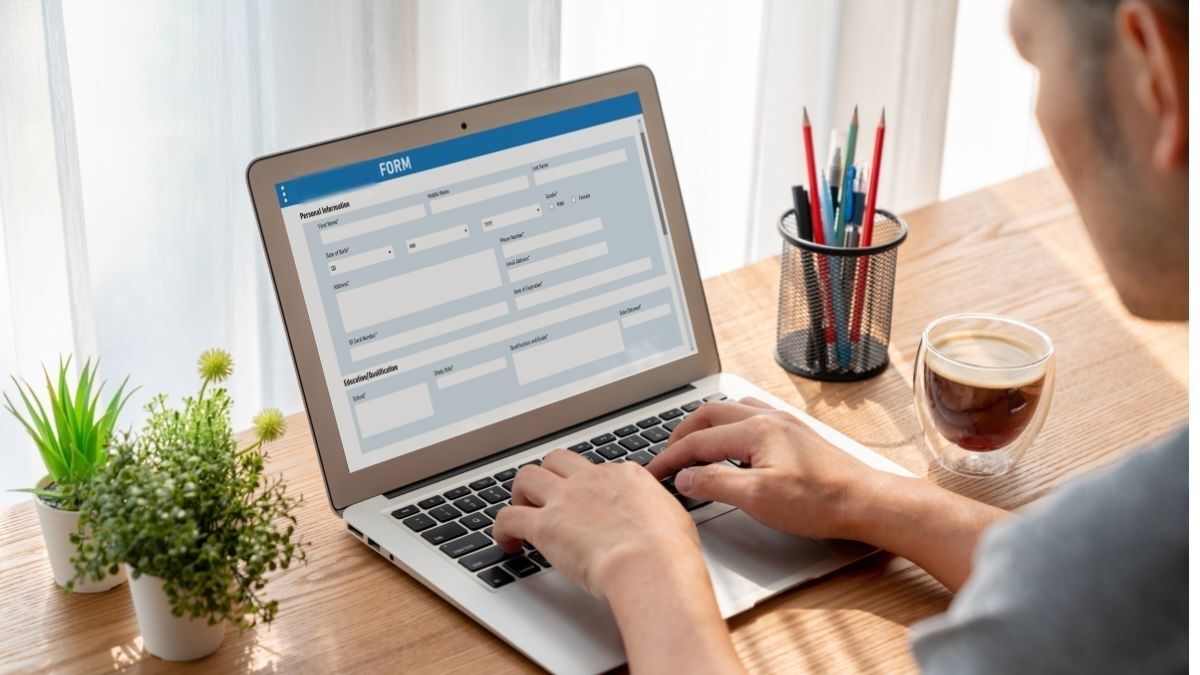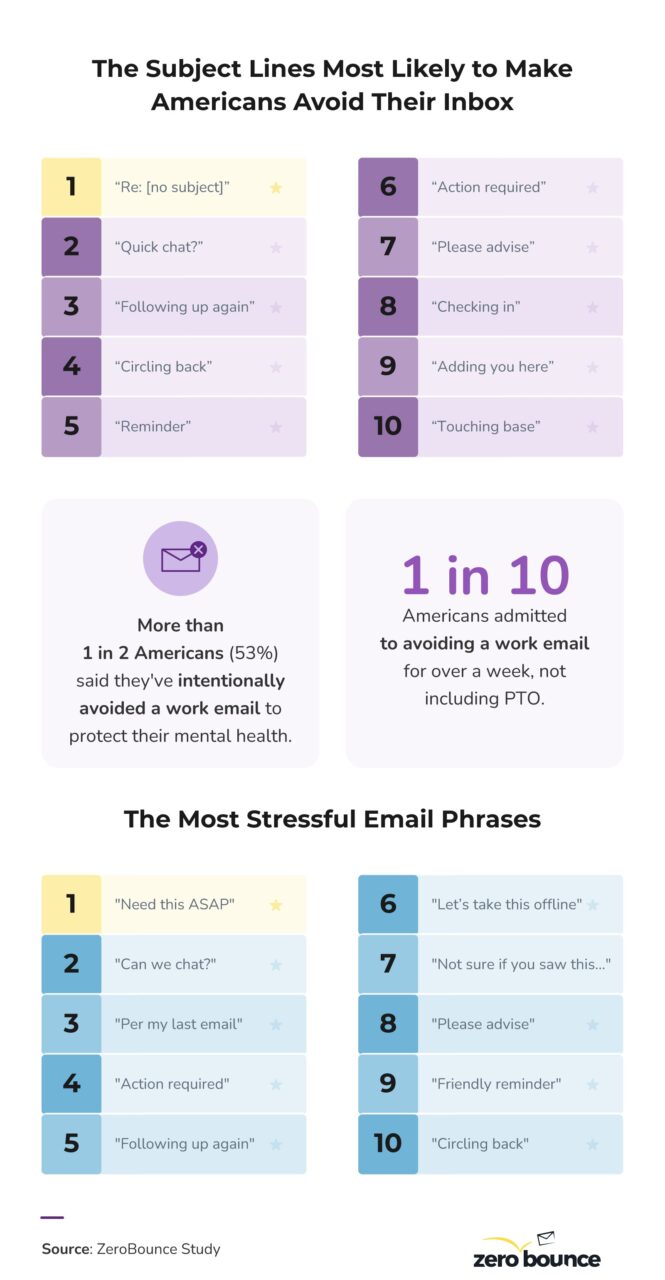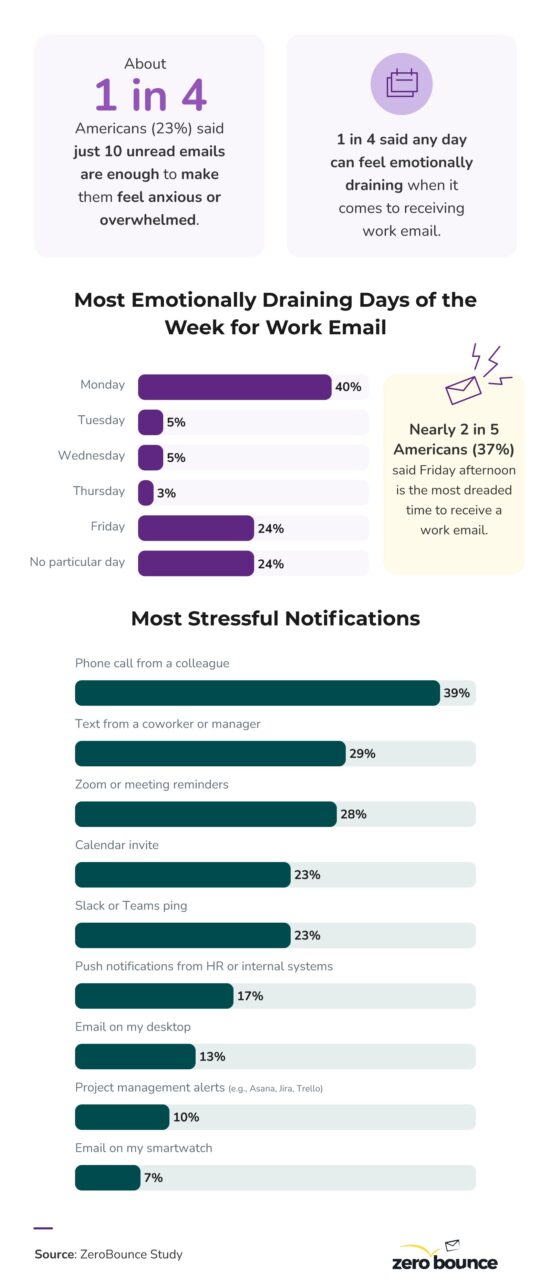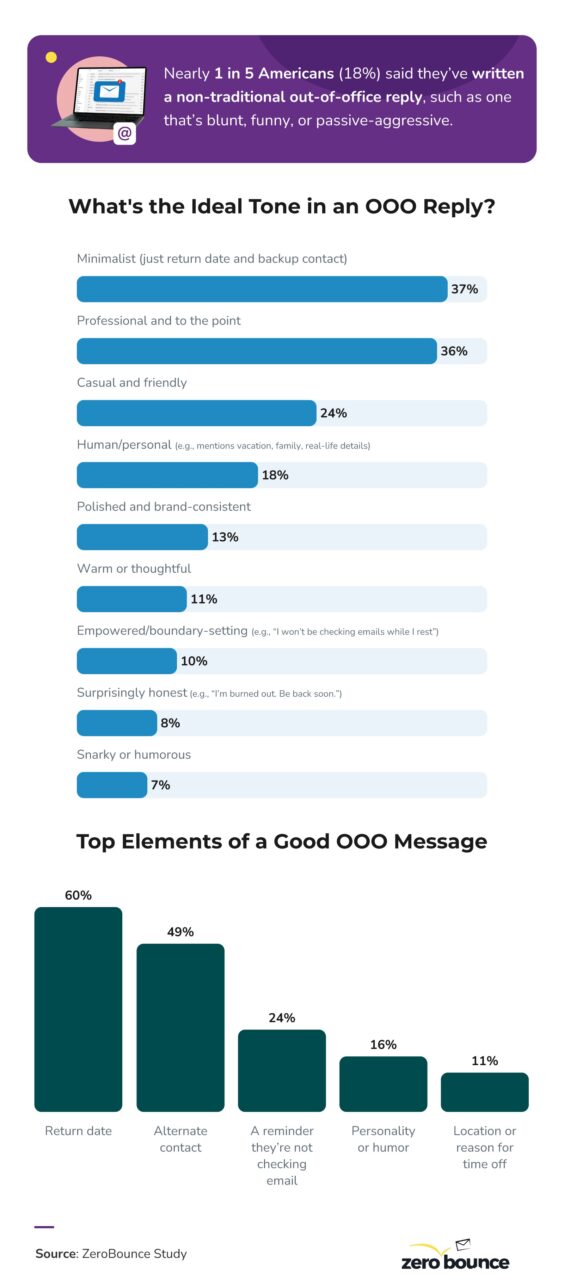
Inbox Exhausted: What Email Habits and OOO Messages Reveal About Burnout Culture
In today’s workplace, the inbox is no longer just a digital to-do list. It can also reflect how people feel. From passive-aggressive sign-offs to vanishing into OOO oblivion, professionals are making bold emotional statements with how they handle email.
ZeroBounce surveyed 1,000 American workers to understand how their email habits reveal stress, anxiety, and evolving expectations about availability. What surfaced is a snapshot of burnout culture playing out one subject line at a time.
Key takeaways
- Over half of Americans (53%) intentionally avoid a work email to protect their mental health.
- The most stressful email phrases are “Need this ASAP,” “Per my last email,” and “Action required.”
- About 1 in 4 Americans (23%) say just 10 unread emails are enough to make them feel anxious or overwhelmed.
- 1 in 10 Americans admit to avoiding a work email for over a week, not including PTO.
- Nearly 1 in 10 Americans (8%) spend 20+ hours per week checking or managing their inbox during work hours.
- 39% of Americans have used ChatGPT to adjust their tone in a work email.
Email avoidance isn’t just procrastination
Professionals are ghosting their inboxes, not out of laziness, but to stay sane. Email avoidance has become a coping mechanism for modern workplace stress.

More than half of professionals said they’ve intentionally dodged a work email to protect their mental health. For 10% of workers, that avoidance stretched over a week, even when they weren’t on PTO. On average, Americans said they’ve delayed replying to an email for three days if they’re not on leave.
The triggers for this behavior are everywhere. Nearly half (47%) said they avoid anything sent after hours. Others dodge group emails with vague tasks (35%), unclear or out-of-scope requests (34%), emotionally draining messages like apologies or conflict (34%), or emails with attachments that require deep focus (29%).
Subject lines don’t help either. The most-used but least-liked phrases include “Just checking in” (28%), “Quick question” (26%), “Per my last email” (24%), and “Thanks in advance” (22%). Still, people keep using them, perhaps out of habit or the fear of sounding rude. Respondents also said “Need this ASAP,” “Per my last email,” and “Action required” cause the most stress.
Then there’s the tone dilemma. Forty-two percent reread emails twice, and another 41% reread them three or more times to ensure they don’t sound off. Nearly one in four Americans (23%) believe emojis are totally professional in work emails, while others play it safe with AI: 39% have used ChatGPT to fine-tune their tone.
Why the overthinking? Thirty-six percent say it’s their job title or level that makes them second-guess their tone. Others blame their personality (32%), gender (22%), or even race or ethnicity (10%).
About half (51%) said they don’t worry about sounding robotic like AI, but the other half are making conscious changes. These include writing more casually (23%), avoiding overly polished phrasing (19%), shortening emails (17%), using contractions (12%), ditching em dashes (10%), and even sprinkling in typos or quirks (6%) just to sound more human.
The inbox is a quiet stress machine
Unread messages can become a source of anxiety. From after-hours pressure to doomscrolling threads, the inbox is wearing people down.

On average, Americans spend six hours per week managing email during work hours, while 10% clock over 20 hours weekly. Inbox doomscrolling is very real, with 39% compulsively checking their inbox even when they know it stresses them out. In fact, 61% have forgotten to reply to an email entirely because of stress or anxiety.
The average American starts to feel overwhelmed after 65 unread emails pile up. A quarter said that even 10 is enough to raise their blood pressure. Even after hours, the inbox lingers. Most people spend one hour a week checking emails off the clock, with 7% spending five or more hours. After-hour email stress doesn’t always come from the message itself, as 43% said it depends on who’s sending it. Still, 28% said after-hours emails are always disruptive, no matter the source.
Many are taking action to protect their peace. Over two in five Americans have either removed (28%) or considered removing (15%) their work email app from their phone. And nearly one in ten (8%) say AI tools have actually helped reduce their inbox stress. That said, not everyone is glued to their inbox; 41% don’t check emails outside of work at all.
OOO replies are saying what employees can’t
Auto-replies are getting personal in the working world. Professionals are using their OOO messages to vent, joke, and sometimes subtly cry for help.

Nearly one in five Americans (18%) admitted to crafting blunt, funny, or passive-aggressive out-of-office messages. Another 15% said they’ve used their OOO to hint at burnout or set hard boundaries. That boundary-setting isn’t going unnoticed, as 38% of respondents said they’ve removed someone from an email thread because that person’s OOO made them seem unavailable or because they wanted to avoid unnecessary replies.
Then there’s the AI factor. Nearly 2 in 5 Americans (39%) have used ChatGPT to adjust their tone in a work email. One in five suspected that another worker’s OOO message had been written by artificial intelligence. Of those, 12% cited awkward phrasing or errors, and 8% pointed to overly polished language. Yet for 41%, this idea hadn’t even crossed their minds as they’d never considered that an OOO message might be AI-generated.
Conclusion: Your inbox says a lot
Many Americans have shared that burnout often shows up in the way they write, avoid, and respond to emails. But small changes can help. Setting boundaries, taking breaks, and using tools to manage your tone or workload can make a big difference. Your inbox will always be there, but it doesn’t have to wear you down.
Methodology
We surveyed 1,000 American workers to explore how modern professionals are using email and out-of-office replies to express stress, avoid conflict, and redraw boundaries. The average age of respondents was 40; 47% were female, 52% were male, and 1% were nonbinary.
About ZeroBounce
ZeroBounce helps professionals reclaim their inboxes with tools designed to improve email deliverability, validate contacts, and optimize outreach. Whether you’re trying to boost engagement or reduce bounce rates, ZeroBounce keeps your emails out of the void.
Fair use statement
If you’d like to share this data for noncommercial purposes, feel free. Just include a link back to ZeroBounce to give proper credit.






